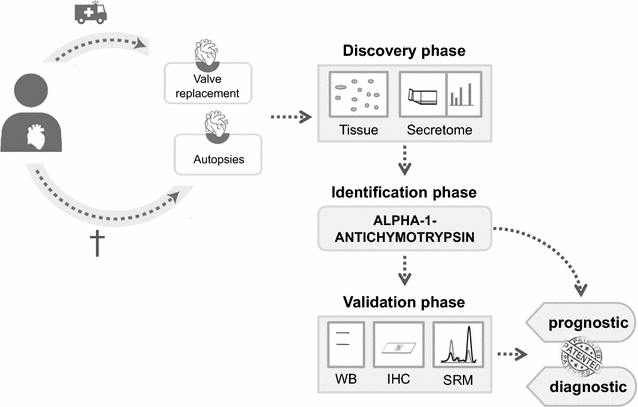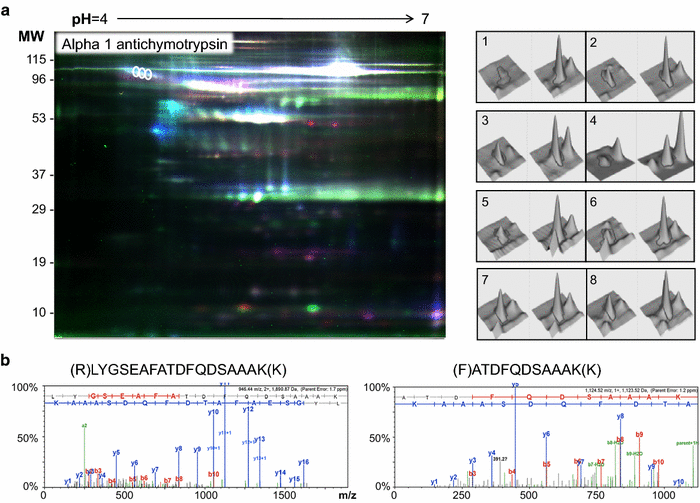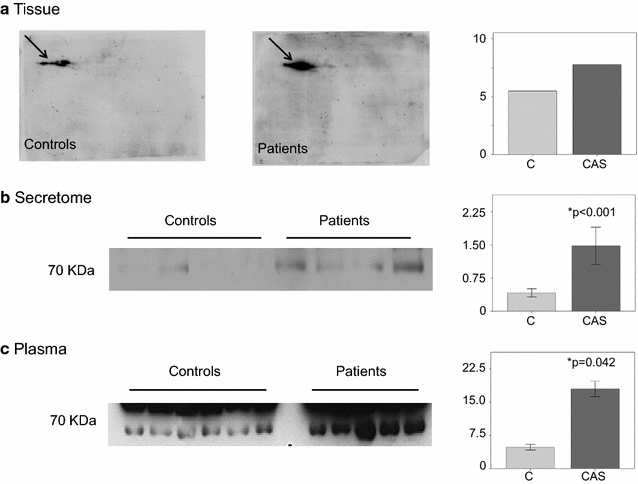A clinical perspective on the utility of alpha 1 antichymotrypsin for the early diagnosis of calcific aortic stenosis
- PMID: 28439213
- PMCID: PMC5399387
- DOI: 10.1186/s12014-017-9147-z
A clinical perspective on the utility of alpha 1 antichymotrypsin for the early diagnosis of calcific aortic stenosis
Abstract
Background: Calcific aortic stenosis (CAS) is the most common heart valve disease in the elderly, representing an important economic and social burden in developed countries. Currently, there is no way to predict either the onset or progression of CAS, emphasizing the need to identify useful biomarkers for this condition.
Methods: We performed a multi-proteomic analysis on different kinds of samples from CAS patients and healthy donors: tissue, secretome and plasma. The results were validated in an independent cohort of subjects by immunohistochemistry, western blotting and selected reaction monitoring.
Results: Alpha 1 antichymotrypsin (AACT) abundance was altered in the CAS samples, as confirmed in the validation phase. The significant changes observed in the amounts of this protein strongly suggest that it could be involved in the molecular mechanisms underlying CAS. In addition, our results suggest there is enhanced release of AACT into the extracellular fluids when the disease commences.
Conclusions: The significant increase of AACT in CAS patients suggests it fulfils an important role in the physiopathology of this disease. These results permit us to propose that AACT may serve as a potential marker for the diagnosis of CAS, with considerable clinical value.
Keywords: Alpha 1 antichymotrypsin; Biomarker; Calcific aortic stenosis; Multi-proteomic.
Figures





Similar articles
-
Application of a new procedure for liquid chromatography/mass spectrometry profiling of plasma amino acid-related metabolites and untargeted shotgun proteomics to identify mechanisms and biomarkers of calcific aortic stenosis.J Chromatogr A. 2017 Sep 29;1517:66-78. doi: 10.1016/j.chroma.2017.08.024. Epub 2017 Aug 12. J Chromatogr A. 2017. PMID: 28851525
-
Identification of GlcNAcylated alpha-1-antichymotrypsin as an early biomarker in human non-small-cell lung cancer by quantitative proteomic analysis with two lectins.Br J Cancer. 2016 Mar 1;114(5):532-44. doi: 10.1038/bjc.2015.348. Epub 2016 Feb 23. Br J Cancer. 2016. PMID: 26908325 Free PMC article.
-
A comprehensive study of calcific aortic stenosis: from rabbit to human samples.Dis Model Mech. 2018 Jun 19;11(6):dmm033423. doi: 10.1242/dmm.033423. Dis Model Mech. 2018. PMID: 29752279 Free PMC article.
-
Alpha-1-antichymotrypsin as a novel biomarker for diagnosis, prognosis, and therapy prediction in human diseases.Cancer Cell Int. 2022 Apr 19;22(1):156. doi: 10.1186/s12935-022-02572-4. Cancer Cell Int. 2022. PMID: 35439996 Free PMC article. Review.
-
Blood, tissue and imaging biomarkers in calcific aortic valve stenosis: past, present and future.Curr Opin Cardiol. 2018 Mar;33(2):125-133. doi: 10.1097/HCO.0000000000000487. Curr Opin Cardiol. 2018. PMID: 29194051 Review.
Cited by
-
The Influence of Coronary Artery Disease in the Development of Aortic Stenosis and the Importance of the Albumin Redox State.Antioxidants (Basel). 2022 Feb 5;11(2):317. doi: 10.3390/antiox11020317. Antioxidants (Basel). 2022. PMID: 35204200 Free PMC article.
-
Exosome-Derived Mediators as Potential Biomarkers for Cardiovascular Diseases: A Network Approach.Proteomes. 2021 Feb 1;9(1):8. doi: 10.3390/proteomes9010008. Proteomes. 2021. PMID: 33535467 Free PMC article. Review.
-
Comprehensive Proteomic Profiling of Pressure Ulcers in Patients with Spinal Cord Injury Identifies a Specific Protein Pattern of Pathology.Adv Wound Care (New Rochelle). 2020 May 1;9(5):277-294. doi: 10.1089/wound.2019.0968. Epub 2020 Mar 19. Adv Wound Care (New Rochelle). 2020. PMID: 32226651 Free PMC article.
-
Effects of Growth Hormone Treatment and Rehabilitation in Incomplete Chronic Traumatic Spinal Cord Injury: Insight from Proteome Analysis.J Pers Med. 2020 Oct 21;10(4):183. doi: 10.3390/jpm10040183. J Pers Med. 2020. PMID: 33096745 Free PMC article.
-
Current evidence regarding the cellular mechanisms associated with cancer progression due to cardiovascular diseases.J Transl Med. 2024 Jan 26;22(1):105. doi: 10.1186/s12967-023-04803-2. J Transl Med. 2024. PMID: 38279150 Free PMC article. Review.
References
LinkOut - more resources
Full Text Sources
Other Literature Sources
Miscellaneous
